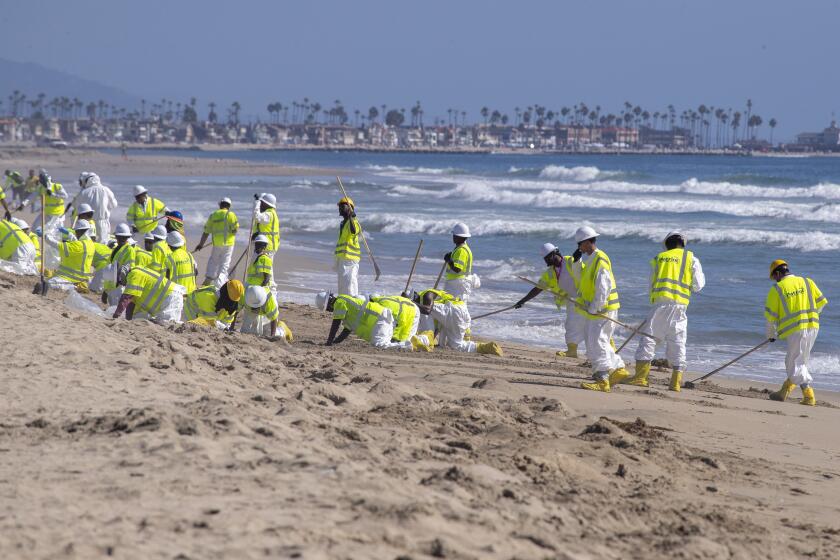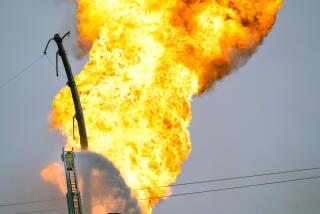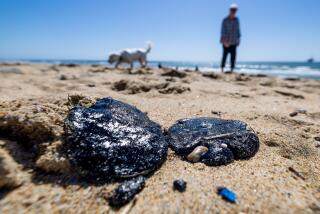O.C. oil spill leaves many clues, but so far, few answers
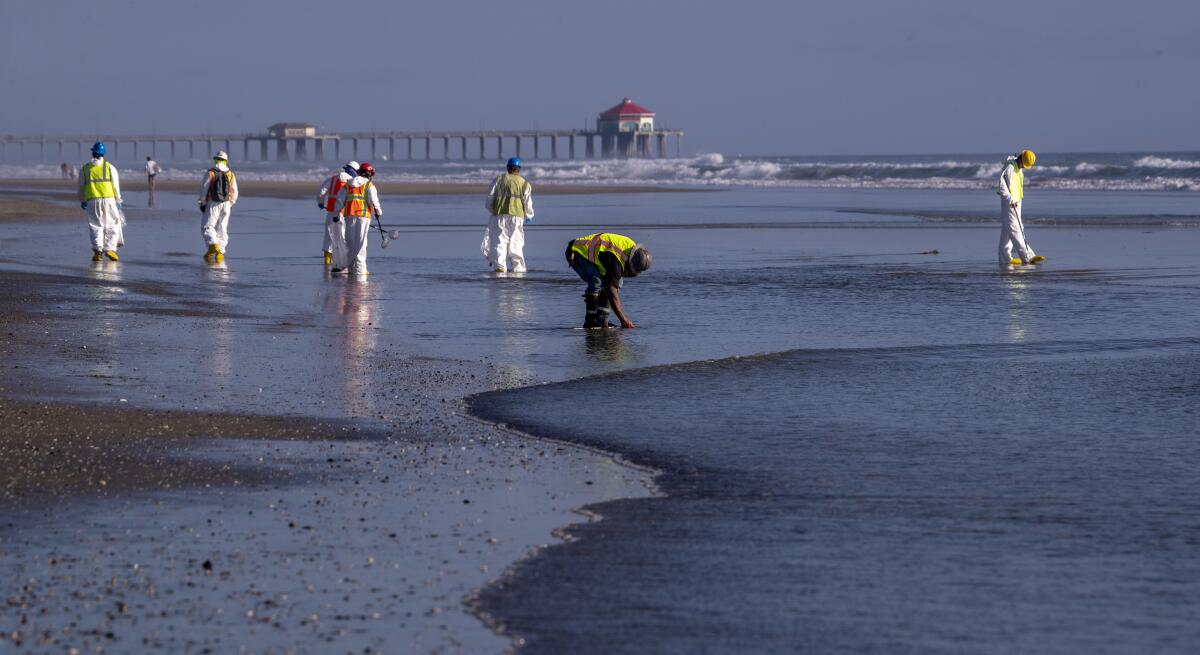
- Share via
Nearly a week after a 13-inch tear in an undersea pipeline resulted in a massive oil spill off the Southern California coast, the clues keep piling up, but the mystery of what caused the rupture and who is ultimately responsible remains unsolved.
Like other investigations into mechanical failures that have led to catastrophic results, an understanding of the chain of events that led to the spill is playing out like a twist-filled thriller. Leads are being followed. Some have already resulted in dead ends; others are still unfolding.
It’s still unclear how the pipeline ruptured, when the damage was done and what could have prevented it. Even the exact location of the pipe running along Orange County coast is also the subject of some doubt.
“The frustrating part is that the information is coming at investigators at the speed of light, and they can be inundated with irrelevant noise,” said Richard Kuprewicz, who by his account has investigated hundreds of pipeline incidents over the course of 20 years. “They have to filter that out of the way.”
As containment and mitigation efforts advance, nearly a dozen government agencies have become involved in an investigation that has already taken them to the Port of Oakland, where authorities spoke Wednesday to the operators of a German container ship that had been on-site at the time of the spill. The ship was allowed to continue on with its journey, however, and the ship’s owners said the vessel was no longer under scrutiny.
A massive oil spill off the Orange County coast has fouled beaches and killed birds and marine life
Kuprewicz warns that answers may take time.
“We should have an answer in a couple of months, which is about how long it takes to do the forensic analysis,” he said, which should include removing the damaged pipe from nearly 100 feet of water. “They should be able to determine with a high degree of confidence what the most likely failure mechanism was.”
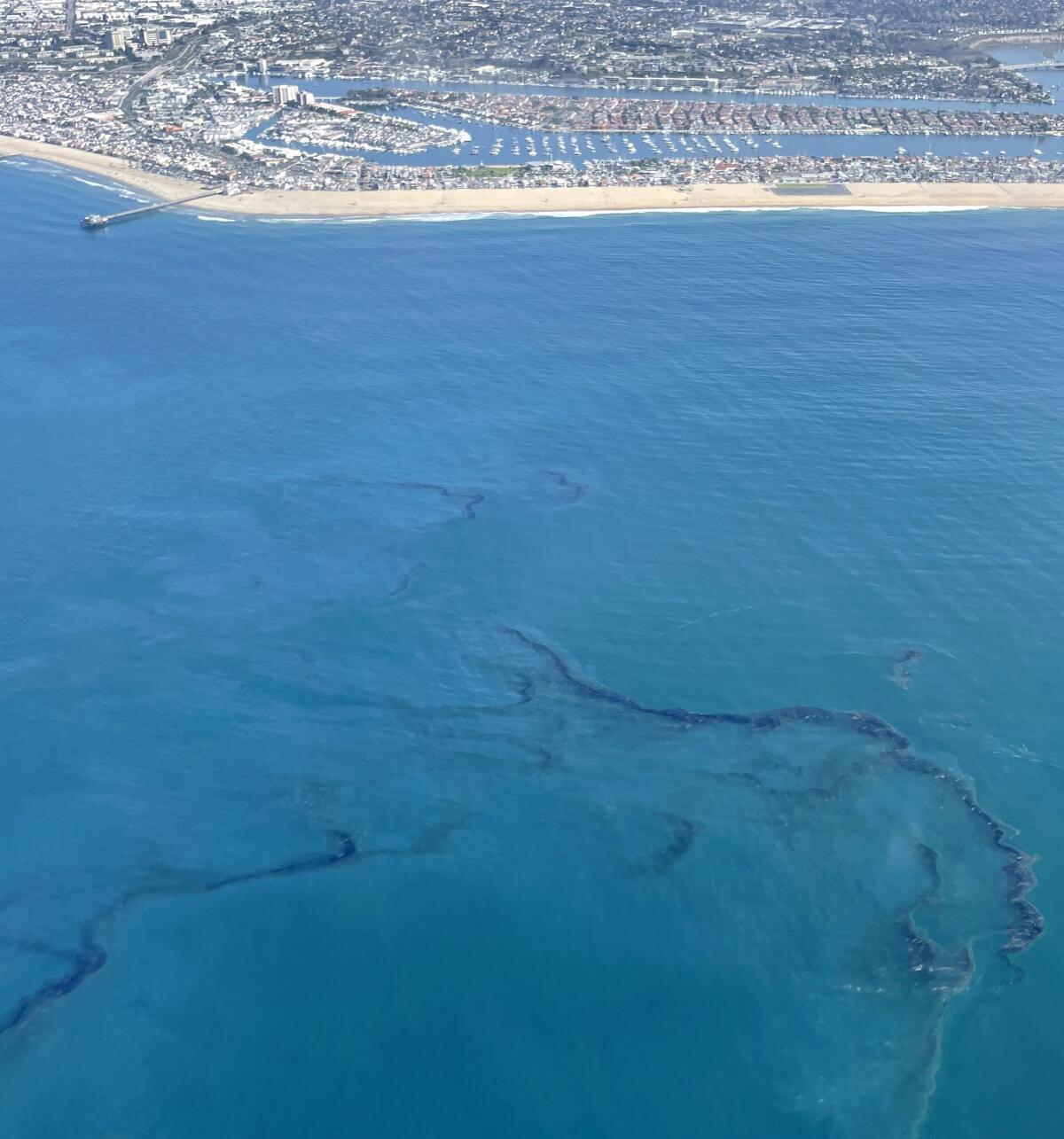
Of course, determining the cause of the rupture will be easier than finding out who is responsible. “It will take more time to get to the who, than to the why,” Kuprewicz said. “The why follows the science. The who follows the rule of law.”
As of Thursday, the most probable suspect continued to be a shipping vessel that might have hit and possibly snagged the pipeline in the process of anchoring. But identifying that ship will require establishing when the pipeline was damaged. Complicating that work is the possibility that damage took place months before the pipe cracked open.
The answer to these questions is critical in not only preventing a similar spill from taking place but also in determining liability, which could possibly extend to criminal negligence.
The full scope of the weekend oil spill in Orange County remains unclear.
Already a performer on the Huntington Beach boardwalk has sued the pipeline operator in federal court, claiming that the spill will harm his business and has exposed him to hazardous chemicals. The lawsuit is seeking class-action status.
On Thursday, another lawsuit filed in federal court on behalf of Laguna Beach shoreline property owners also seek class-action certification and damages for loss of enjoyment, potential lowered property values and diminished rental income.
Rebecca Ore, commander of the U.S. Coast Guard Sector Los Angeles-Long Beach, was reluctant to give an estimated cost of the cleanup. “We’re still in the early phases of this, and responses can be a long-term effort,” she said.
But Kuprewicz anticipates this effort could “easily go into the hundreds of millions.”
“Oil spills don’t tend to be cheap affairs, and this is a high-profile oil spill with a high-profile investigation,” he said. “I’ve seen minor pipeline failures that have escalated into billions of dollars.”
Orange County Supervisor Katrina Foley said there is a federal liability trust that will be used to reimburse public agencies for the cost of the cleanup. It is not clear how much money is in the trust.
“We are tracking every single minute, every single supply, piece of equipment,” Foley said. “All the public agencies are working towards submitting reimbursements. I don’t have any reason to believe we won’t get reimbursed.”
Seven days into the investigation, what is known is clear: The pipeline, which is 16 inches in diameter, is nearly 18 miles long, and connects three offshore oil platforms — Ellen, Elly and Eureka — with an onshore processing plant in the Port of Long Beach.
The infrastructure is owned by Amplify Energy Corp., a publicly owned energy company headquartered in Houston. Its portfolio, according to its website, includes “mature, legacy oil and natural gas fields.”
Amplify has owned the property for nine years. It was initially developed by Shell Oil Co. in the late 1970s and went into production in January 1981. It is one of more than two dozen offshore oil platforms that are a familiar sight off the coast.
Late in the afternoon of Friday, Oct. 1, Newport Beach resident Jolie Sheppick noticed a smell, “like when they resurfaced the streets in the area and had a spill.”
But even as Sheppick and others began calling authorities, workers in Platform Elly’s control room were unaware of a problem in the pipeline until 2:30 a.m. Saturday when, according to federal regulators, they received an alert indicating low pressure.
Low-pressure alerts do not always mean a release in the line, and “it isn’t reasonable to expect an operator to shut down a line whenever they hear a low-pressure alarm,” said Kuprewicz, but “something doesn’t look right here.”
In comments this week, Martyn Willsher, who runs Amplify Energy, has not explained what warnings his company may have received or what initial actions they took.
He has said, however, that a little after 8 a.m. Saturday, workers performing a line inspection noticed a sheen in the water and “instantly” radioed back to the offshore platforms, where workers launched an incident response plan. The offshore platforms and pumping operations were “shut down immediately thereafter.”
About half an hour later, Amplify Energy notified its crisis and emergency management company and federal regulators, according to Willsher, adding, “If we were aware of something on Friday night, I promise you — we would have immediately stopped all operations.”
The initial suspect was corrosion. “Steel pipes want to corrode,” Kuprewicz said.
Even if the pipeline was damaged by a ship anchor, corrosion could have played a role in the rupture, slowly compromising the steel at the point where it was weakened or stressed, but investigators will also take into consideration other factors, independent of an anchor strike or corrosion, including a manufacturing defect at welding sites.
Given these possibilities, the role that inspections could have played in preventing the spill will come under scrutiny.
Offshore platforms and pipelines are monitored by a raft of federal regulatory agencies that are mandated to conduct periodic inspections of aging equipment. In California, their work alone focuses on more than two dozen platforms from just north of Point Conception to Huntington Beach. Some are in state waters, some are in federal waters, and all are about 40 years old.
“It’s not a robust system of oversight,” said Miyoko Sakashita, oceans program director for the Center for Biological Diversity.
Newly released documents from the federal Bureau of Environmental Safety and Enforcement show that the broken pipeline had been inspected every two years since 2007 by private contractors hired by Amplify Energy.
In 2019, repairs were made in three areas where pipeline deformation occurred, according to the summary report by federal investigators. “The internal inspection is acceptable and no remedial action is recommended at this time,” the bureau concluded.
But as speculation grows over the role that corrosion and lax government oversight may have played in the spill, the Joint Unified Command, overseeing the investigation, announced on Tuesday that divers and footage from remotely operated submarines discovered that a 4,000-foot section of the pipeline had been violently displaced.
“The pipeline has essentially been pulled like a bowstring,” said Willsher, describing some force that had pulled the pipe about 105 feet in an almost “semicircle.”
The suspicion that an anchor might have caught and dragged the pipeline comes at a time when disruptions in the global supply chain, due to the pandemic, have led to a fivefold increase in traffic over the last few years. The bottleneck has required many more ships to wait at anchor before entering the ports.
Not long after the spill, early analysis of satellite imagery suggested that the container ship might have crossed the pipeline after straying thousands of feet from its anchorage.
After examining the images, however, the nonprofit environmental watchdog group Skytruth said it had found no evidence of drifting.
On Wednesday, Coast Guard officials boarded the ship that was in Oakland at the time and later released it without explanation. The ship is currently in route to Mexico.
The owner of the ship, Hapag-Lloyd, was aware that some marine traffic information showed that it had moved while it was anchored, but that “seems to be wrong,” a company spokesman said. The ship’s captain has provided logs, updated hourly, showing the ship did not leave its anchorage place for several days, he said.
Tracking down the responsible ship could prove extremely difficult. Investigators haven’t always been able to find the culprit in suspected anchor strikes of underwater pipelines, or even come to a final conclusion that it was an anchor that caused damage, federal records show.
Investigators continue to look into the possibility that other ships damaged the pipeline, but some have raised the question of whether the pipeline might have moved so that its position on nautical charts was no longer accurate.
As the investigation continues, Kuprewicz advises patience. The first priority is to contain and mitigate the spill. Other answers will come in time, he said.
“The public tends to make conclusions that outpace the science,” he said. “They think they can solve this right off the bat. But there is a due process to these procedures. The rule of law applies, and this process takes a while.”
Times staff writers Robert J. Lopez, Richard Winton, Hannah Fry, Rosanna Xia and Adam Elmahrek contributed to this report.
More to Read
Sign up for Essential California
The most important California stories and recommendations in your inbox every morning.
You may occasionally receive promotional content from the Los Angeles Times.
